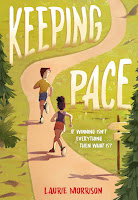

It'sMarvelous Middle Grade Monday
at
and #IMWAYR day
at
I have to say that the beginning of 2024 started out rather well, with April titles being generally MUCH happy than 2023 titles. I only bought 36% of what I read in 2023, because I could not see many of the titles circulating. These too definitely will.
MY favorite is the first, Things That Shimmer, because it brough back my own middle school experience. I'm super excited about it, so kids will read it. They will be somewhat more likely to pick up Morrison's brilliant upper grade Keeping Pace, but both of these books have made me feel much more motivated to read new middle grade instead of retreating to the comfort of Cleary and Weber.
Lakritz, Deborah.
Things That Shimmer April 2, 2024 by Kar-Ben Publishing ®
E ARC provided by Netgalley
Melanie Adler is dealing with a lot at home; her family was in a car accident, and her mother was badly injured. Because of this trauma, she suffers from migraines and chronic anxiety, to the point where she panics is Melanie isn't home from school right away. Melanie has things to worry about at school as well; it's 1973, and she's read enough Teen Beat to know that as a 7th grader, she should be popular. Her long time best friend, Vicky, is starting to hang out with the popular crowd known as "the Shimmers", but Melanie herself isn't able to attract the attention of the queen bee. Instead, she gets picked by the principal to show the new girl around. Dorit Shoshani was born in Israel, and her father fought in the Six-Day War. Dorit has moved around enough to know that there are always popular girls, and she has no interest whatsoever in jumping through the hoops to be one of them. She and Melanie become good friends, especially when her family buys a house in the same neighborhood. The two are both dealing with family trauma; living with parents with PTSD is not easy, and this was a period of time when this was not identified or treated in the way it is now. Instead of worrying about make up, boys, or clothes, the two are more interested in swimming at the pool, doing crafts, and dancing to the new Carpenters' album. When Melanie is paired with the popular Marla in the Girls' Foods, the two enjoy working together, and Melanie is invited to Marla's bat mitzvah celebration. Vicky is not, but the fact that Melanie might be considered for the Shimmers renews Vicky's interest in her old friend. Unfortunately, this new popularity does not endear her to Dorit. When the Yom Kippur war takes place, Dorit is very stressed, and the family eventually decides to move back to Israel. Melanie wants to try to make amends before her friend moves away. Will she be able to?
Strengths: This is perhaps the very best example of including historical details that I have seen. It helps that I have experienced many of the historical details personally and can attest to the veracity of every single one.
The New Betty Crocker Boys' and Girls' Cookbook, complete with Mad Hatter Meatballs and Flopsy Mopsy Carrots? On my bookshelf as we speak. Love's Babysoft Perfume? Still have a bottle. Watergate, Snoopy posters, pink-and-green bedrooms,
Go Ask Alice, mood rings, The Partridge Family, baby oil at the pool, and innovations like blow dryers, digital wrist watches, and computer-printed schedules are all mentioned, along with the coup de grâce: a glass cup that "looks like an ice-cream sundae but it's really a candle that smells like strawberries" and wallpaper that is "green and gold flowers that look like popcorn balls" and is FUZZY.
Whew. Sorry. Time traveled back to 1973 for a moment to the hallway of my best friend's house. Seriously. This was exquisiste.
There are good points NOT related to my own personal childhood. The parallel experiences of parental trauma the girls must deal with is a good bonding mechanism. At its heart, this is a story of personal identity and the age old middle school experience of losing friends because you grow in different directions. It doesn't matter if this happens when you are wearing the bell bottoms and maxi dresses of the 1970s, the low slung jeans and chokers of the 1990s, or the Crocs and Buffalo Plaid pajama pants of the 2020s; it still hurts the same. This story could be told in a modern setting, but I loved that this is based off some of the author's real life experiences and related in all of the green shag glory of 1973.
Weaknesses: This is set in an indeterminate middle American town with a university, but it must have been one hip and happening place to allow girls to wear not only PANTS to school, but worn out JEANS. That, along with a mention of yogurt in a school lunch when the author CLEARLY meant to say
"Delmonte Pudding Cup", is a slight anomaly that I would be remiss in not mentioning.
What I really think: This is a must purchase for any middle school to bolster the historical fiction section and will be great displayed along with other 1970s historical fiction like Collard's
Double Eagle, Shang's
The Way Home Looks Now, Dumas'
It Aint' So Awful, Falafel, Bithell's
Brave Bird at Wounded Knee, Kalmar's
Stealing Mount Rushmore, Parson's
Clouds Over California, Farmer's
Malcolm and Me, Woodson's
Remember Us, Budhos'
The Long Ride, Frank's
Armstrong and Charlie, Hitchcock's
One True Way, Amos'
Cookies and Milk, Alikhan's
Marika Marches for Equality, Nokowitz's
The Prince of Steel Pier, Supplee's
The Sweetness All Around, Jones'
Finding My Place, Toalsen's
Colors of the Rain, graphic novels Harper's
Bad Sister, Martin's
MexiKid, Russo's Why is Everybody Yelling, Copeland's
Cub, Holm's
Sunny Side Up, and Tavares'
Hoops,and Kuzki's
Soul Lanterns and Smith's
Dawn Raid (for an international perspective!).
Morrison, Laurie.
Keeping PaceApril 9, 2024 by Amulet Books
E ARC Provided by Edelweiss Plus
Grace is stressing about her last exams in 8th grade; ever since she started middle school, she has wanted to win the top scholar award and have her name on a plaque in the school hallway. She has two major motivations for this plan; she hopes that maybe her father, a famous writer who was impressed by the award, will want to spend more time with her after her parents' divorce, and also, she hopes to beat her former friend Jonah, with whom she has been in competition since 6th grade. That was the year that her parents divorced, and also the year that Jonah's father died. There were a series of miscommunications that have estranged the two. This is even more difficult because Jonah's grandmother lives right next door to Grace. Her older sister, Celia, and her cousin Avery (who was born the same week she was) tell her to calm down, and to make plans for the summer that don't involve competition, because people should be more than their accomplishments. Devastated when she doesn't win, Grace makes plans for her summer, since she did not make it into an exclusive writing workship she had hoped to attend. Her goals include getting a haircut (Avery's idea), having her first kiss (also Avery's idea), and taking a class. When she meets Jonah when she is out running, a new goal emerges: run a half marathon and beat Jonah. She finds a training plan, and increases the distance on her already long runs. Since Jonah is just starting, she hopes that it will be an easy task. Her training is interrupted by having to babysit the son of her father's new girlfriend, Brie, when Brie is running a storytime at the community center. Sometimes she takes him to the park, where the four year old, experiencing some frustration, runs away. Luckily, Jonah is in the park and catches him. Brie teaches Grace a lot about how to interact with young children so that they can control what they do, and Grace recognizes that this helps a bit what her emotions as well. She and Jonah fall into a pleasant rhythm when they reluctantly train for the marathon together, and do talk about what led to their problems in the past, but in true middle grade fashion, there is another miscommunication. Will Grace be able to set a proper pace for her life, and will she and Jonah be able to communicate properly and remain friends?
Strengths: Morrison is a big advocate for upper middle grade, a cause I support completely. Most midde grade books would benefit from having 8th grade characters, because most children want to read about older characters. Grace is getting ready to go to high school, which intrigues all of my students. I also love that Morrison works sports into her books in such an intriguing way. Grace's lists of things to get done spoke to me VERY loudly; I have a quarter sheet of scrap paper every day with a lengthy list, especilly in the summer! I coached cross country, and it is definitely a sport that appeals to self-driven personalities like Grace. Her animosity towards Jonah is very realistic; I may still hold grudges about people with whom I went to middle school. It's more likely that children have parents who are divorced than deceased, and the logistics of going between two houses could be addressed much more in middle school literature. If authors want emotional dynamite to mine, this is the way to go! Celia and Grace have a great relationship, and having a cousin nearby is fantastic, especially since the two are so different; Avery admitting that sometimes SHE would like to be the one to help Grace was great. There is some age appropriate, very sweet romance that just puts the perfect icing on this story.
Weaknesses: Grace is very obsessed with grades, and it's good to see her trying to balance her emotions about that, but the comment is made several times that we are not our accomplishments. Boy, did that make me think all day! I even posed this question to many staff members. This seems to fall along generational lines. People my age and older agree with me that we are most certainly our accomplishments. Younger people don't. I will have to agree to disagree on this topic philosophically. Even though my GPA in high school was lousy (3.2? I managed to get a scholarship to study Latin, the money being available because few others were foolish enough to agree to a major that would not lead to permanent employment!), my entire self identity is tied to what I can accomplish. Is Morrison's message a better one for young people? Only time will tell.
What I really think: Like Morrison's
Coming Up Short,
Up For Air, and
Every Shiny Thing, which she cowrote with Celia Jensen (who gets a shout out in this book), this is a thought provoking novel of friendship and life lessons that will appeal to a wide range of readers. I'm glad to add this to my list of
cross country running books that includes Vicker's
Half Moon Summer.














.jpg)







































